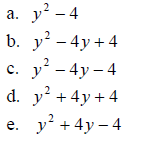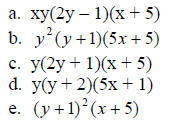- Home
- INTERMEDIATE ALGEBRA
- Course Syllabus for Algebra I
- Mid-Plains Community College
- FRACTION OF A WHOLE NUMBER
- Systems of Linear Equations
- MATH FIELD DAY
- Course Outline for Finite Mathematics
- Calculus
- Algebra Final Examination
- Math 310 Exam #2
- Review of Trigonometric Functions
- Math 118 Practice test
- Precalculus Review
- Section 12
- Literal Equations
- Calculus Term Definitions
- Math 327A Exercise 2
- Public Key Algorithms II
- Maximizing Triangle Area
- Precalculus I Review for Midterm
- REVIEW OF A FIRST COURSE IN LINEAR ALGEBRA
- Math 6310 Homework 5
- Some Proofs of the Existence of Irrational Numbers
- ALGEBRAIC PROPERTIES OF MATRIX OPERATIONS
- Math 142 - Chapter 2 Lecture Notes
- Math 112 syllabus
- Math 371 Problem Set
- Complex Numbers,Complex Functions and Contour Integrals
- APPLICATIONS OF LINEAR EQUATIONS
- Week 4 Math
- Fractions
- Investigating Liner Equations Using Graphing Calculator
- MATH 23 FINAL EXAM REVIEW
- Algebra 1
- PYTHAGOREAN THEOREM AND DISTANCE FORMULA
- Georgia Performance Standards Framework for Mathematics - Grade 6
- Intermediate Algebra
- Introduction to Fractions
- FACTORINGS OF QUADRATIC FUNCTIONS
- Elementary Algebra Syllabus
- Description of Mathematics
- Integration Review Solutions
- College Algebra - Applications
- A Tip Sheet on GREATEST COMMON FACTOR
- Syllabus for Elementary Algebra
- College Algebra II and Analytic Geometry
- Functions
- BASIC MATHEMATICS
- Quadratic Equations
- Language Arts, Math, Science, Social Studies, Char
- Fractions and Decimals
- ON SOLUTIONS OF LINEAR EQUATIONS
- Math 35 Practice Final
- Solving Equations
- Introduction to Symbolic Computation
- Course Syllabus for Math 935
- Fractions
- Fabulous Fractions
- Archimedean Property and Distribution of Q in R
- Algebra for Calculus
- Math112 Practice Test #2
- College Algebra and Trigonometry
- ALGEBRA 1A TASKS
- Description of Mathematics
- Simplifying Expressions
- Imaginary and Complex Numbers
- Building and Teaching a Math Enhancement
- Math Problems
- Algebra of Matrices Systems of Linear Equations
- Survey of Algebra
- Approximation of irrational numbers
- More about Quadratic Functions
- Long Division
- Algebraic Properties of Matrix Operation
- MATH 101 Intermediate Algebra
- Rational Number Project
- Departmental Syllabus for Finite Mathematics
- WRITTEN HOMEWORK ASSIGNMENT
- Description of Mathematics
- Rationalize Denominators
- Math Proficiency Placement Exam
- linear Equations
- Description of Mathematics & Statistics
- Systems of Linear Equations
- Algebraic Thinking
- Study Sheets - Decimals
- An Overview of Babylonian Mathematics
- Mathematics 115 - College Algebra
- Complex Numbers,Complex Functions and Contour Integrals
- Growing Circles
- Algebra II Course Curriculum
- The Natural Logarithmic Function: Integration
- Rational Expressions
- QUANTITATIVE METHODS
- Basic Facts about Rational Funct
- Statistics
- MAT 1033 FINAL WORKSHOP REVIEW
- Measurements Significant figures
- Pre-Calculus 1
- Compositions and Inverses of Functions
Math Proficiency Placement Exam
The following is a list of competencies addressed on the exam.
The student will be able to:
1. Simplify real number expressions using order of
operations.
2. Graph points and intervals of points on the real number line.
3. Classify real numbers as rational, irrational, integer, and/or non-integer
values.
4. Identify real number properties such as commutativity, associativity,
distributive law, identities, and inverses.
5. Translate verbal expressions into algebraic expressions.
6. Simpify algebraic expressions by combining like terms.
7. Evaluate algebraic expressions.
8. Solve linear equations.
9. Construct and use a linear model to solve an application problem.
10. Plot points in the Cartesian plane.
11. Graph a straight line.
12. Determine the x and y-intercepts of a line.
13. Determine the slope of a line.
14. Determine if lines are parallel or perpendicular using slope.
15. Use the point-slope formula to find the equation of a line.
16. Use the slope-intercept form of a line to determine its slope and
y-intercept.
17. Determine whether an expression represents a function using various
techniques, including the Vertical Line Test.
18. Evaluate functions.
19. Find the sum, difference, product, and quotient of functions.
20. Form the composition of functions.
21. Construct and use models to relate quantities that vary directly, inversely,
and/or jointly.
22. Simplify exponential expressions using rules for exponents.
23. Express numbers in scientific notation.
24. Identify the terms and degree of a polynomial.
25. Add, subtract, and multiply polynomials.
26. Factor algebraic expressions using such techniques as common factoring,
factoring by grouping, difference of squares, difference of cubes, sum of cubes,
and trial and error techniques for trinomials.
27. Solve quadratic equations using factoring techniques.
28. Construct and use a quadratic model to solve an application problem.
29. Simplify, multiply, divide, add, and subtract rational algebraic
expressions.
30. Simplify radical expressions using rules for radicals.
31. Determine the domain and range of an exponential function and sketch its
graph.
32. Use an exponential model to solve an application problem.
33. Determine the inverse of a function, if appropriate.
34. Determine the domain and range of a logarithmic function and sketch its
graph.
35. Use a logarithmic model to solve an application problem.
36. Use properties of logarithms to expand and evaluate expressions.
37. Solve exponential and logarithmic equations algebraically.
38. Solve systems of equations involving two equations and two variables.
An excellent source to review before attempting the exam
is Schaum’s Outline of
Intermediate Algebra by Ray Steege and Kerry Bailey (1997, McGraw-Hill).
The format of the exam is multiple-choice. Here are some
sample questions. These
sample questions are designed to give you an idea of the format of the exam. In
no way
is this an exhaustive list of topics covered on the exam.
1. The expression ( y − 2)^2 is equivalent to

The correct answer is B.
2. Solve the given equation for the variable.
6 + 2m = 18
a. -6
b. 12
c. 24
d. 6
e. 4
The correct answer is D.
3. Factor the expression 

The correct answer is C.
4. Solve the system of equations.
3x – 5y = 7
-x + y = -1
a. (-1, -2)
b. (-3, 2)
c. (1, -4)
d. (2, 1)
e. (-1, -4)
The correct answer is A.
5. Simplify the expression


The correct answer is B.


